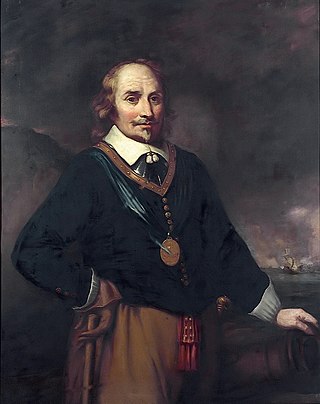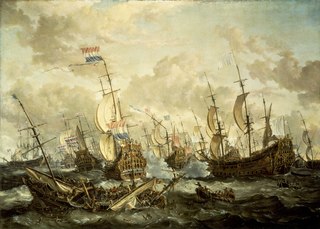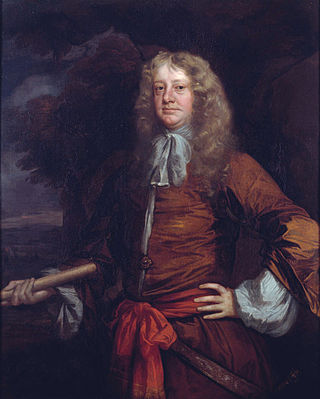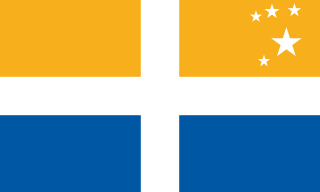
The First Anglo-Dutch War, or First Dutch War, was a naval conflict between the Commonwealth of England and Dutch Republic. Largely caused by disputes over trade, it began with English attacks on Dutch merchant shipping, but expanded to vast fleet actions. Despite a series of victories in 1652 and 1653, the Commonwealth was unable to blockade Dutch trade, although English privateers inflicted serious losses on Dutch merchant shipping.

Maarten Harpertszoon Tromp or Maarten van Tromp was an army general and admiral in the Dutch navy during much of the Eighty Years' War and throughout the First Anglo-Dutch War. Son of a ship's captain, Tromp spent much of his childhood at sea, during which time he was captured by pirates and enslaved by Barbary Corsairs. In adult life, he became a renowned ship captain and naval commander, successfully leading Dutch forces fighting for independence in the Eighty Years War, and then against England in the First Anglo-Dutch War, proving an innovative tactician and enabling the newly independent Dutch nation to become a major sea power. He was killed in battle by a sharpshooter from an English ship. Several ships of the Royal Netherlands Navy have carried the name HNLMS Tromp after him and/or his son Cornelis, also a Dutch Admiral of some renown.

The Anglo–Dutch Wars were a series of conflicts mainly fought between the Dutch Republic and England in the mid-17th and late 18th century. The first three wars occurred in the second half of the 17th century over trade and overseas colonies, while the fourth was fought a century later. Almost all the battles were naval engagements.

The Four Days' Battle was a naval engagement fought from 11 to 14 June 1666 during the Second Anglo-Dutch War. It began off the Flemish coast and ended near the English coast, and remains one of the longest naval battles in history.

Michiel Adriaenszoon de Ruyter was a Dutch admiral. His achievements with the Dutch Navy during the Anglo-Dutch Wars earned him the reputation as one of the most skilled naval commanders in history.

The naval Battle of Portland, or Three Days' Battle, took place during 18–20 February 1653, during the First Anglo-Dutch War, when the fleet of the Commonwealth of England under General at Sea Robert Blake was attacked by a fleet of the Dutch Republic under Lieutenant-Admiral Maarten Tromp escorting merchant shipping through the English Channel.

The Battle of Scheveningen was the final naval battle of the First Anglo-Dutch War. It took place on 31 July 1653 between the fleets of the Commonwealth of England and the Dutch Republic. The Dutch fleet suffered heavy losses.

Robert Blake was an English naval officer who served as general at sea and the Lord Warden of the Cinque Ports from 1656 to 1657. Blake served under Oliver Cromwell during the English Civil War and Anglo-Spanish War, and as the commanding Admiral of the Dutch navy during the First Anglo-Dutch War. Blake is recognized as the "chief founder of England's naval supremacy", a dominance subsequently inherited by the British Royal Navy well into the early 20th century. Despite this, due to deliberate attempts to expunge the Parliamentarians from historical records following the Stuart Restoration, Blake's achievements tend to remain relatively unrecognized. Blake's successes, however, are considered to have "never been excelled, not even by Nelson" according to one biographer, while Blake is often compared with Nelson by others.

Admiral Sir George Ayscue was an English naval officer who served in the English Civil War and the Anglo-Dutch Wars who rose to the rank of Admiral of the White. He also served as Governor of Scilly Isles (1647) and Governor of Barbados (1650–1652).

The Battles of Schooneveld were two naval battles of the Franco-Dutch War, fought off the coast of the Netherlands on 7 June and 14 June 1673 between an allied Anglo-French fleet commanded by Prince Rupert of the Rhine on his flagship the Royal Charles, and the fleet of the United Provinces, commanded by Michiel de Ruyter.

The St James' Day Battle took place on 25 July 1666, during the Second Anglo-Dutch War. It was fought between an English fleet commanded jointly by Prince Rupert of the Rhine and George Monck, and a Dutch force under Lieutenant-Admiral Michiel de Ruyter.

Cromwell's Castle is an artillery fort overlooking New Grimsby harbour on the island of Tresco in the Isles of Scilly. It comprises a tall, circular gun tower and an adjacent gun platform, and was designed to prevent enemy naval vessels from entering the harbour. The castle was built in two phases; Sir Robert Blake constructed the tower between 1651 and 1652 in the aftermath of the Parliamentary invasion of the islands at the end of the English Civil War, and Master Gunner Abraham Tovey added the gun platform during the War of Jenkins' Ear around 1739. The tower fell into disuse soon afterwards, and in the 21st century is managed by English Heritage and open to visitors.
Events from the year 1651 in England, third and final year of the Third English Civil War and final year of the Wars of the Three Kingdoms.

Sir Edward Spragge was an Irish-born English admiral of the Royal Navy. He was a fiery, brilliantly accomplished seaman who fought in many great actions after the restoration of King Charles II in 1660.

The Isles of Scilly is an archipelago off the southwestern tip of Cornwall, England, United Kingdom. One of the islands, St Agnes, is over four miles further south than the most southerly point of the British mainland at Lizard Point.
Castle Down is a windswept plateau of maritime heath in the northern part of the island of Tresco, Isles of Scilly. The area has a number of designations including Castle Down (Tresco) Site of Special Scientific Interest (SSSI); is part of the Isles of Scilly Area of Outstanding Natural Beauty; part of the Isles of Scilly Heritage Coast; and part of Plantlife's Isles of Scilly Important Plant Area. There are a number of Schedule Ancient Monument's ranging in age from Bronze Age cairns to castles built in the 16th and 17th centuries to protect the anchorage of New Grimsby harbour.

Oliver's Battery is a ruined artillery battery on the island of Tresco in the Isles of Scilly off of Cornwall, England. It was built by the Parliamentarian admiral, Sir Robert Blake, after he invaded Tresco in April 1651 during the years of the interregnum. It was used to bombard the neighbouring island of St Mary's, which was still held by an opposing Royalist army, and forced its surrender several weeks later. The battery comprised a triangle of ramparts, constructed using earth and rubble, which, combined with the natural stone features on the site, produced a substantial, if crude, fortification. It is now ruined, and owned by the Duchy of Cornwall.

Brederode was a ship of the line of the Maas Admiralty, part of the navy of the United Provinces of the Netherlands, and the flagship of the Dutch fleet in the First Anglo-Dutch War. Throughout her career, she carried from 49 to 59 guns. She was named after Johan Wolfert van Brederode, the brother-in-law of stadtholder Frederick Henry, Prince of Orange.

The Dutch States Navy was the navy of the Dutch Republic from 1588 to 1795. Coming into existence during the Eighty Years' War, the States Navy played a major role in expanding and protecting the Dutch colonial empire, in addition to participating in numerous conflicts with rival European powers. The States Navy consisted of five admiralties, which were respectively based in Amsterdam, Friesland, the Noorderkwartier, Rotterdam and Zeeland. This organisational structure contributed to the decentralised nature of the States Navy, which heavily relied upon privateers and armed merchantmen in times of war.

















